April 2009
“Sieze the Day”, she said
Central Chile
There we were, sitting in the McDonald’s (damn fine wifi -- boring food) on Highway 68 between Santiago and Valparaíso, in the center of Chile, talking to a German couple whom we’d last seen when we were all camped beside a lake south of San Martín de los Andes in the Argentine lake district in December. They’d been going by on the highway, heading for Valparaíso. They spotted us, caught a retorno or two, and swung in to say hi. We were sitting there talking about places to visit in Brasil, where the Germans had spent considerable time. The little counter girl came up to us and showed us this piece of paper saying “Seize the Day.” She wanted us to tell her what it meant in Spanish. With my Carpe Diem for a useless beginning, and using hand gestures and the Germans’ little translator gizmo, we were able to help her out. A great moment for international understanding, and surely a fitting title for a newsletter.
* * * * * * * * * * * * *
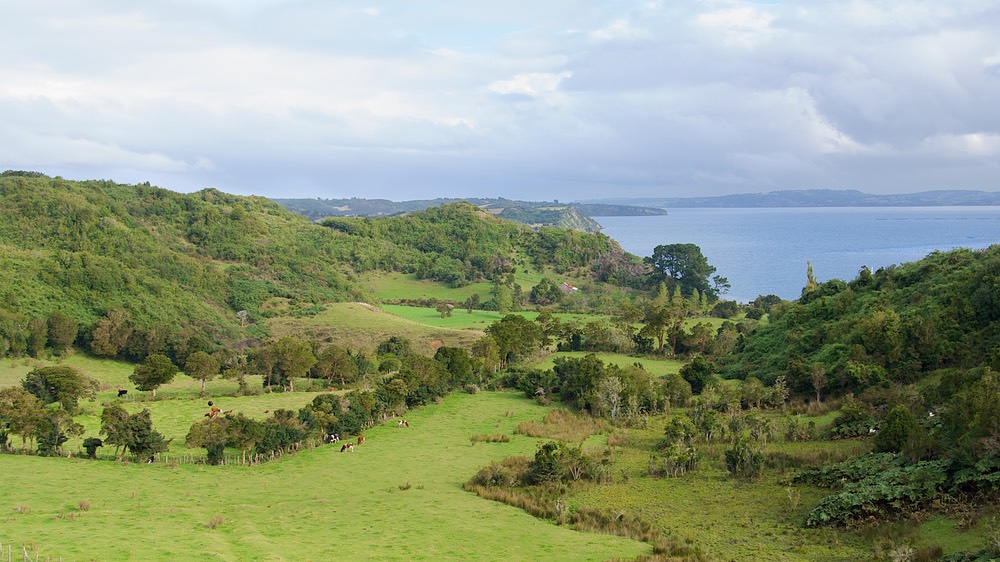
Leaving the Chevrolet dealership in Puerto Montt, after being parked there for a couple of weeks, we immediately had a lifting of spirits, a sense of the mental cloud over our heads floating off on the breeze. The weather wasn’t great, but we didn’t care if it rained for the next 40 days (and nights) – we were on the road again!
Thinking it made sense to hang around the Puerto Montt area for a few days, to be sure all was well, we made the good decision to head out onto the peninsular part of the Chiloé region. Really a series of one very large and many small islands, the entire area is connected to mainland Chile by ferry, about 35 miles west of Puerto Montt. Off we went. The ferry was sitting there waiting for us, a good luck sign.
During the crossing, a nice older man in Chilean navy uniform chatted with us. He spent a long time looking at the map on the side of our coach, and then wanted to discuss with us an upcoming trip for himself and his daughter. It seems he has a nephew in the navy who is on a sailing ship, The Esmeralda, a training vessel. It has recently left for a long voyage that will take it up the east coast of the United States, to Quebec, and then to Halifax. He and his daughter were planning to fly to the States, visit several places, and then meet the ship in the harbor in Quebec. It was quite an adventure he was planning, and he wanted to discuss routes, methods of travel, and sights not to miss. We were able to get out all our maps (never, never be without maps of North America!) and give him several suggestions. We had a great time, and we all waved happy goodbyes when the ferry arrived in Chacao.
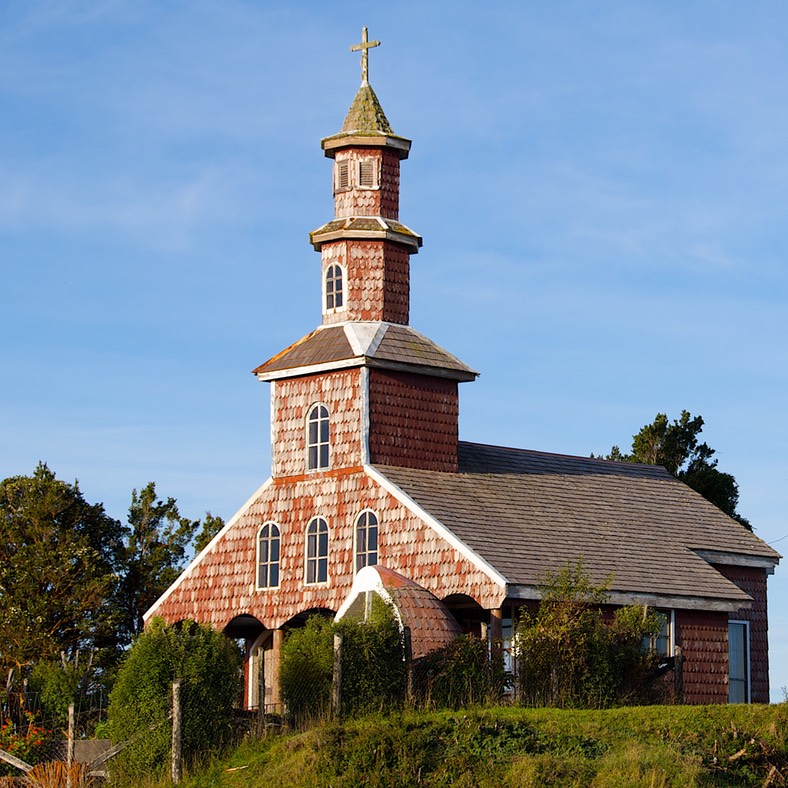
Chiloé is a mind-set; the world passes by slowly, things are as they used to be, houses are old and weathered, churches are simple. We spent several days puttering around, visiting little towns and taking pictures whenever the sun chose to cooperate. The area is well known for its old wooden buildings with interesting patterned shingles; they were pretty cool. The “authentic” ones are intricately shaped, and several pieces are fitted together to both create the pattern and insure the building will be watertight. There are small museums with local history as a focal point. We wanted to visit one, in Chemchi, that had pictures of a huge tsunami that destroyed bunches of the peninsula’s structures in 1960. Rats; it had just closed and wouldn’t be open again for two more days; we didn’t want to stay that long. Missed the pictures; enjoyed the town anyway.
Castro is the biggest town in the area, and is famous for its historic fishermen’s homes built on stilts along the water’s edge. Just as we were there the sun came out for a bit, and we were able to enjoy the bright colors of the houses.
We followed little roads until they petered out; we spent nights along waterfronts in small fishing towns with little else going on; it was all very pleasant and a great experience. We can see why “mainlanders” have cabins out here (some of them more than just “cabins”); it is a quiet and serene way of life. We were reminded of the Gaspé peninsula in Quebec, or Cape Breton Island in Nova Scotia.
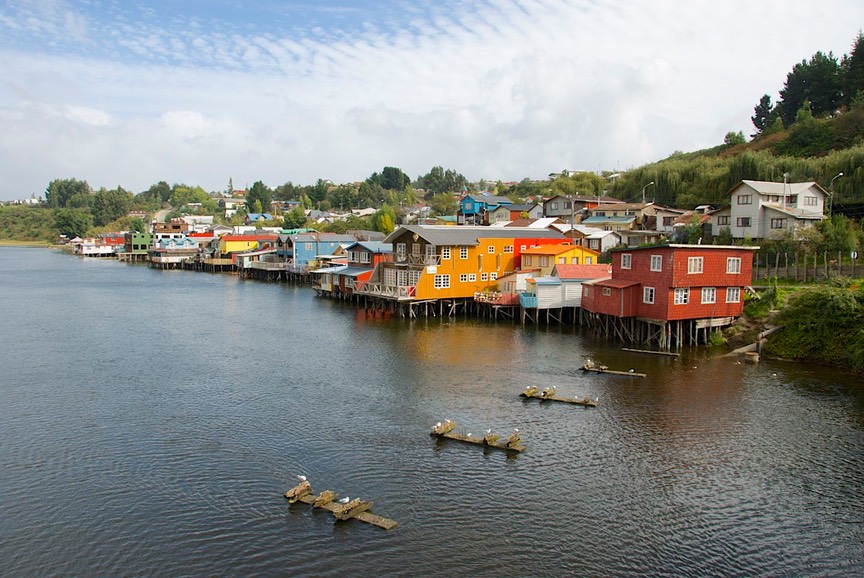
The area has, in recent times, been somewhat transformed by the salmon fisheries. All along the coastlines there were farms offshore; an ugly change, according to many. Where the soil is good, inland we also saw lots of neat and tidy farms, along with plenty of cows and sheep. Apple orchards were plentiful, with ripe fruit on the trees, along with blackberries along the roadsides.
Doing fine, but a bit of a hiccup with the truck again. So we cut short some of our exploring, and headed back across the ferry. After a short return visit to the Chevy guys: “Oh, no,” they said, but were as charming as always in getting us attended to. Problem taken care of, we were off again.
We had another area in the vicinity that we also wanted to visit, now for two reasons. Southeast of Puerto Montt is the beginning, the northern end, of the Carretera Austral. (This, of course, is the mother (of a) road we had been on when La Tortuga died outside Río Tranqilo. It runs south from Puerto Montt to Villa O’Higgins, with land gaps that are covered by ferries; it’s roughly 500 miles in length.) We’d been robbed of the chance to see very much of this wild and wonderful countryside, and here was a chance to see a little. We also chose this road because we knew parts of it were rough, slippery and difficult; what better way to make sure our baby was really ready to leave the nest (Salfa Sur Chevrolet).
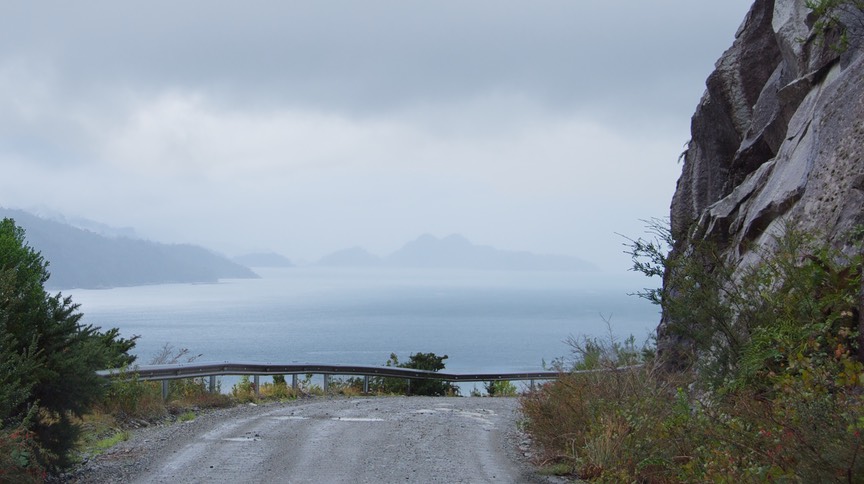
So we headed southeast down Route 7 (the CA), took the ferry across the Seno Reloncaví, entered mainland Chiloé, and immediately noticed we had left civilization behind. The land was rugged, the pavement disappeared, and we were in the middle of a rain forest. Water rushed down the mountainsides; everywhere it was green; rain and fog enveloped us. Talk about a change of scene!
We spent most of two days working our way back up the east side of Reloncaví, enjoying the wilderness. The coastline was similar to the Olympic Peninsula in Washington State. Salmon and mussel farms lined the coves; this is a controversial issue, of course, as the pristine scene is ruined (for some); we enjoyed the area very much. Apple trees were full, berries were plentiful, and the trees were all turning yellow.
After two rugged days without a hitch, we skirted Puerto Montt (PM), and resumed the adventure of working our way north in Chile. We had officially left Patagonia in the rear-view mirror.
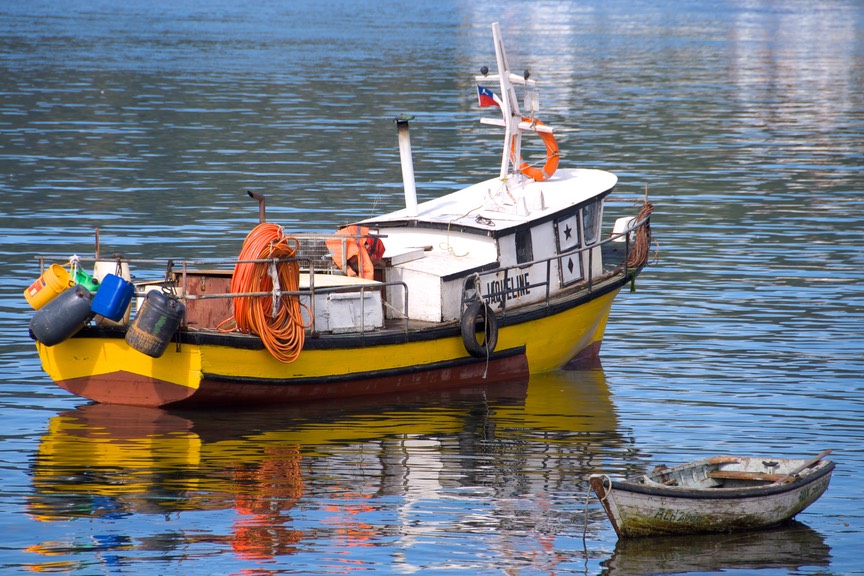
The city of PM sits at the top end of the Golfo de Ancud, a huge sound off the Pacific Ocean, on a south-facing slope overlooking the bay. As you move north from there, and come over the top of the hills, you very quickly enter a different landscape. Suddenly the countryside is green, with rolling hills; it’s a gentler climate. Dairying country, it was settled by Germans and all is neat and tidy; it’s Chile’s Lake District.
This is a popular resort area (as is the area at the same latitude on the Argentine side), and there were plenty of people around. We were aware that we were approaching Semana Santa (Holy Week) and Easter, and realized the area might be impacted. But the area was lovely (although it rained a lot) and we enjoyed driving around, seeing the lakes and the volcanoes (seldom, because of the clouds).
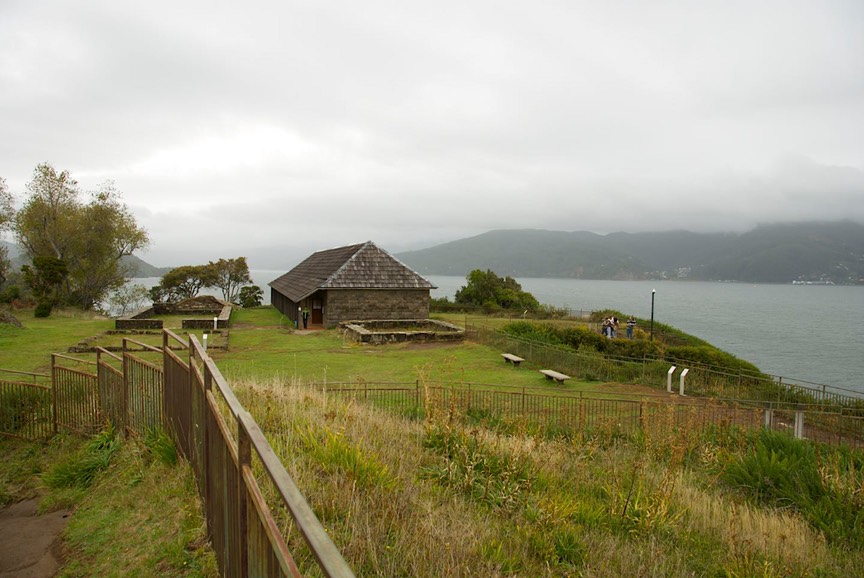
We stopped in Valdivia, along the coast, to see the old fortifications. Valdivia is an old city in a well-protected harbor. The Spanish built the forts there in the 17th century; at the time they comprised the largest fortified complex on the Pacific coast of the Americas. They stood until Lord Cochrane wiped them off the face of the earth (almost) in 1820 as he helped Chile gain her independence. The ruins are quite interesting and the museum has lots of cool information (Spanish only, sad to say, but we did our best).
Valdivia is also known for its terrific fresh produce and fish market, which is right on the river. There is a pretty waterfront there, and it makes a great sight. We were particularly pleased because this was the first fresh market we had seen in several months, and the vegetables were enormous. It was great to be back in farming country!
Still in Valdivia, we discovered a store selling “living closets” – this in English, mind you – we pondered that one for quite awhile. Any ideas?
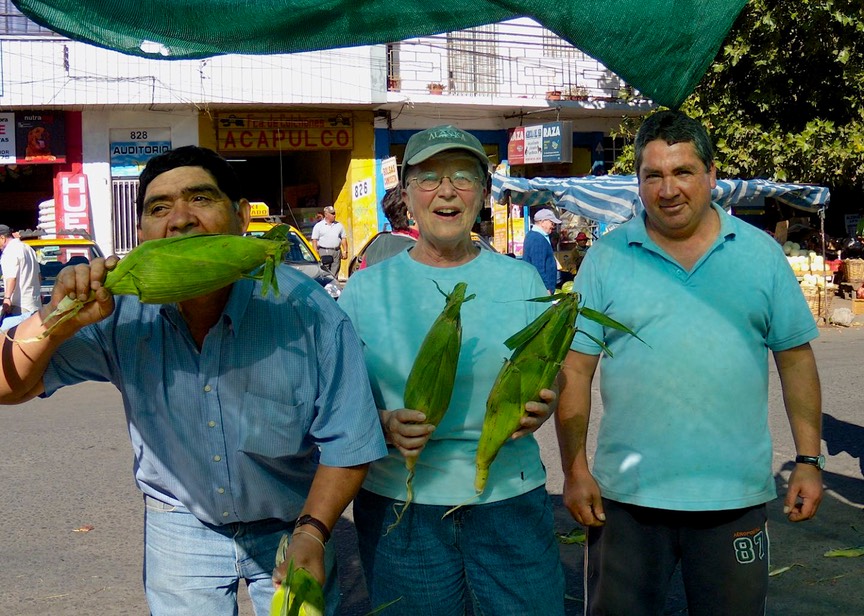
Still rainy, we were torn between knowing the sun was out further north and not wanting to skip areas others had really enjoyed. So we took the road to Villarrica, near the famous volcano (Chile’s most active) of the same name, despite someone’s muttering about not being able to see anything in this weather. (He was right of course.) But still it was interesting country, and we spent a nice night beside Lago Villarrica, on the edge of the nice little town of the same name. We poked around nearby Pucón a little; bigger, more commercial and touristy, less interesting, and even exhibiting a – gasp – ReMax for sale sign. Definitely too developed for us.
On we went. And suddenly we were in sunshine – lovely, warm sunshine. A cause to rejoice. Grooving on the weather, we headed for the very interesting town of Chillán. This small city is known for an incredible marketplace. It certainly did not disappoint. This was the best fresh food market we had seen since Ecuador! Kathy went ape, Rick played burro (as well as taking pictures), and we had a ball. The finest avocado since Mexico; the biggest carrots ever…well, you get the picture.
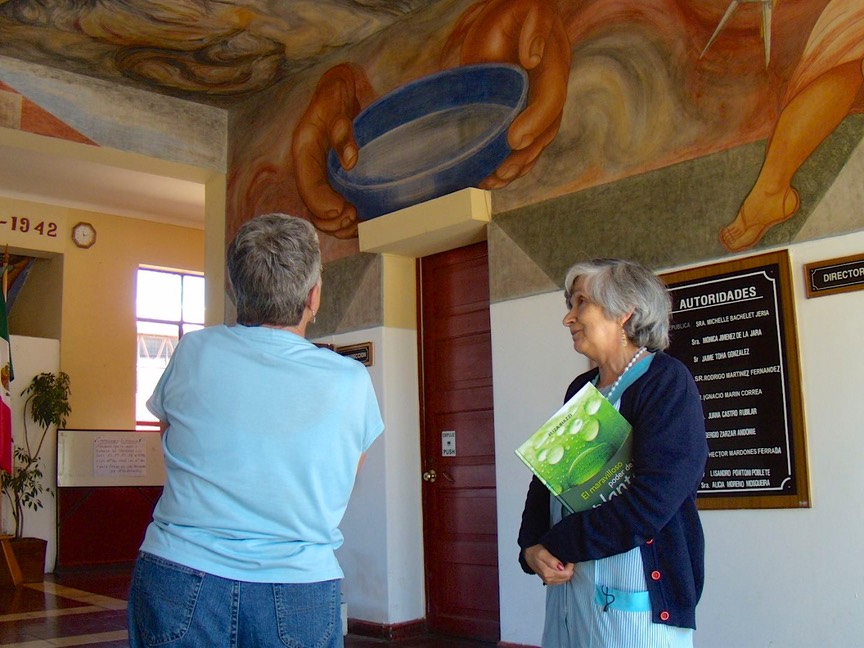
This is a daily market, and it is quite an enterprise. It goes for blocks, has anything you could possibly want (not just food), and is very well organized. You are encouraged to buy a re-usable bag for your purchases, and there are clean-up people everywhere, taking away the detritus from the cornhusks (yes, fresh corn!), carrot tops, etc. Rick could hardly drag me away.
We had two other sights to see in town, and they both were superb. The first was at a local school, Escuela Mexico. The school was built by the Mexican government, as part of a relief effort after a terrible 1939 earthquake, and was decorated by famous Mexican muralists Siqueiros and Guerrero. Siqueiros’ work is always very political (he was an outspoken Communist); Guerrero chose to depict the architectural aspect of the building’s construction; it was he who painted a ceiling beam to represent a level. The murals are undergoing restoration right now; the completed ones are incredible. Someone at the school showed us around; it was a remarkable opportunity.
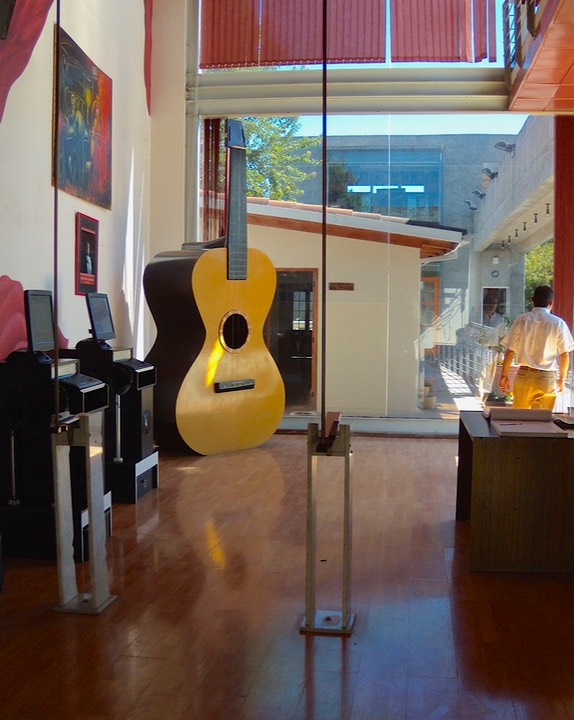
Our other visit was to the Claudio Arrau Museum. Maestro Arrau was a very important and internationally famous pianist who died in 1991; a child prodigy, he was born in Chillán in 1903 and lived there for many years. The museum is on the site of his former home, downtown. There are wonderful exhibits of his things, along with an excellent British film of his triumphant return to Chillán in 1984 and some of the concertizing he did during that visit. It was a moving experience for us, and we were so very glad we had gone. Also on site was an interactive musical instrument museum; it included a guitar large enough to crawl into, and from inside you could hear the sound of the strings being plucked; really cool.
As we moved north up through Chile, we were mostly traveling on Route 5, the autopista. It’s hard not to; other roads go off to specific towns and areas, but there really aren’t parallel roads you can take to keep you off the highway. So you get used to it. Visually, we remarked how familiar it all seemed: it was very much like traveling up and down a combination of I-5 and Highway 101 in California. We (Rick) noticed that all the girls at the tollbooths were lovely and polite and well dressed. The road was in good shape. There were plenty of fuel stations to stop at, often with wifi, and even some rest areas for variety. And the land was mostly cultivated and very productive. We soon were in wine country, and vineyards had taken over the world. It’s a nice drive from Puerto Montt to Santiago (the road goes right on up to the Peruvian border, of course).
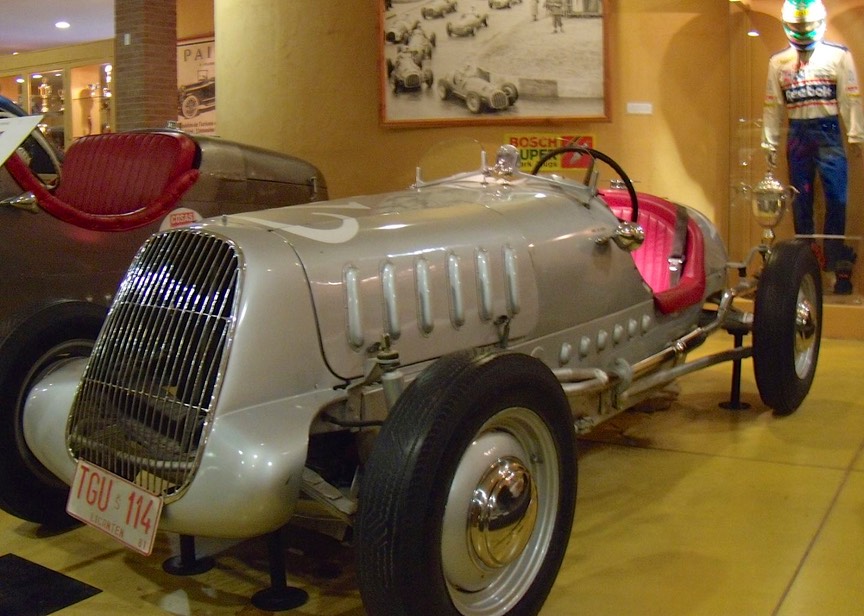
But you do want to get off after awhile. We took a side road to the city of Santa Cruz, a good choice. This is another very old city, in wine country, one with a real western feel. There was even a rodeo planned for the coming weekend. Our stop was in order to visit the Colchagua Museum, which has a very large and extremely well presented collection of pre-Columbiana and historical materials. It’s housed in a cool old building, and was a real treat. Having spent many months traveling in Latin America, we were able to recognize lots of “old friends” on exhibit. The museum grounds house antique farm equipment and even an old train. Oh, and a separate indoor exhibit of antique cars. It’s a beautiful museum and we had a really good time.
We were happy to head toward Santa Cruz in part because it was west of the autopista and on a road that would take us toward the coast, which we thought would be a good idea. We were getting close to both Easter and Santiago, which we thought might be a bit of a zoo. Unfortunately we ended up on a road that proved both boring and full of truck traffic. It was Route 66 (which had a ring to it); it went through a very fertile growing area (fresh strawberries along the road), but the towns were grubby, it was dry and cactus-y, and not so great. Reminded us of northern Mexico.
After a bit we decided to check out where all our friends might be at this time. And we got lucky. Our French family had gone to ground in a campground not too far away; they were visiting Santiago for a couple of days but would be back soon. We decided to go see how they were doing.
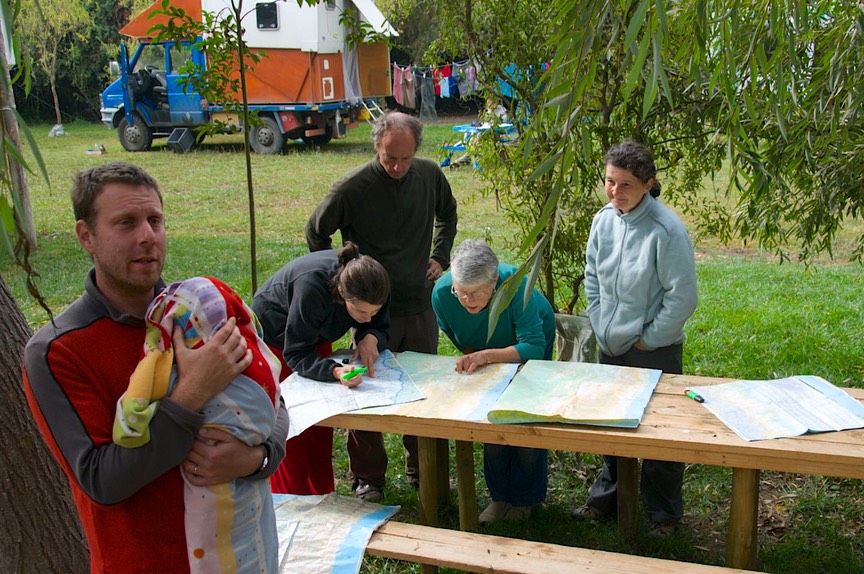
Campgrounds in the area around Santiago are abundant and very pleasant. All of Santiago, it seems, goes camping. And we found that our French friends were not alone: they were in the company of 3 other French families, all with children, all on the road for several years and schooling their children as they went. The French government has developed programs that make this possible for young families, and we have seen many of them as we’ve traveled along. In addition to the organized home schooling, the parents are entitled to up to three years sabbatical from their employment, at no pay of course, but assured of a position with their company when they return. We think this is quite marvelous. The schooling program is quite strict, with frequent deadlines, hairy exams, etc., all of which require several hours of schooling every day. Not a free ride. Sometimes you could see that the strain of keeping this regime under control was taking its toll. But mostly they were very happy.
We referred to this grouping as the French Quarter and spent a couple of lovely days with these 4 families and their 11 children (including a month-old baby). Listening to “when we shipped from India to Australia,” and “but in Africa,” really kept us stirred up.
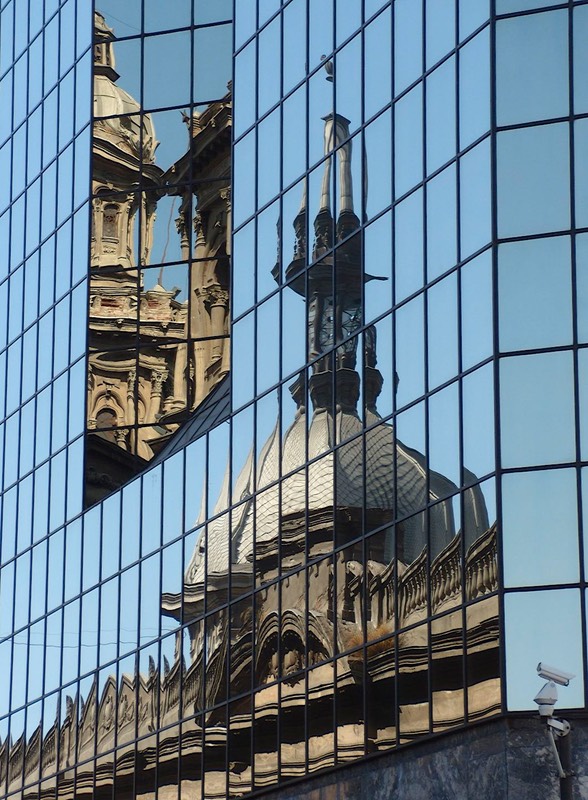
The new baby (a fourth girl for the family) had been born in Puerto Varas, a short distance down the road. She (Maud) was getting regular check-ups and shots, and was a delight. Their oldest, who was 12, had been born in Pittsburgh, of all places! Daddy works in the steel industry, and he talked about the exciting things we could look forward to when we went to Brasil, where he had worked for a year. We hated to say goodbye to all these great people, from whom we had received many offers of places to stay and people to visit when we were in France.
Despite the intense smog, the worst we had seen in many a year, we decided to go on into Santiago (about 25-30 miles away) and see the sights for a bit; which we did, including seeing the governmental palace, which had been strafed and bombed during the military coup that put Pinochet in power. Can you imagine?
Pinochet was in power from 1973-1989. A truly brutal man, and a truly brutal regime; it was filled with death and torture. There is a site in Santiago that is at the location of one of the torture centers. A former villa, thatt has now been razed and the grounds made into a park, the Parque por la Paz. It spoke eloquently to us through its exhibits, its rose garden, its markings on the ground showing where cells were. If you should visit Santiago, be sure to go there.
Before leaving the area, we revisited the mall where we had purchased our cameras in January. Called the Parque Arauco, we think it’s the loveliest public space we have ever seen. It’s in the classy, eastern section of the city, with lots of greenspace and the Río Mapocho not far away. We were there on a balmy evening; a classical group was playing on a raised platform (well attended), there was plenty of outdoor dining to be had, and a very nice cinema (we were able to see the movie “Milk,” with Sean Penn, which was incredible). It was a mob scene; apparently “going to the mall on Saturday night” isn’t exclusively an American habit. We really enjoyed our taste of “the good life” in the capital city.
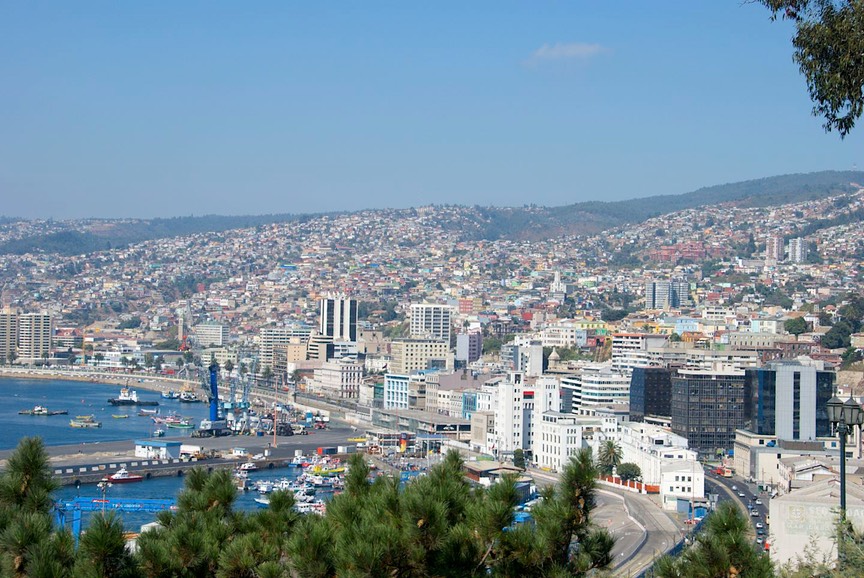
So – the next day was Easter Sunday. Obviously, we had not followed our dictum of staying away from the crowds over the holiday. So, when were we going to visit Valparaíso? We had been told the city was easy to visit on Sundays, so maybe today would be good. We got an early start and headed for the coast and the port town. Well, so did the rest of Santiago, at least that part of the city that had not been there all week, enjoying the beach. Valparaíso was a total zoo. But we enjoyed ourselves anyway, spending a lot of time at the naval museum, which is on a hill overlooking the harbor.
We then beat a hasty retreat, making our way back towards Santiago. By this time we were keeping an eye out for our Australian friends, Yasha and Jürgen, who were actively trying to sell their truck and camper, as their time in South America was rapidly drawing to a close and they needed to sell their rig before they left. As it turns out, this is a bit difficult, as no country down here wants you to leave behind anything you brought with you, but they continue to work with interested parties in trying to find a way to make it happen.
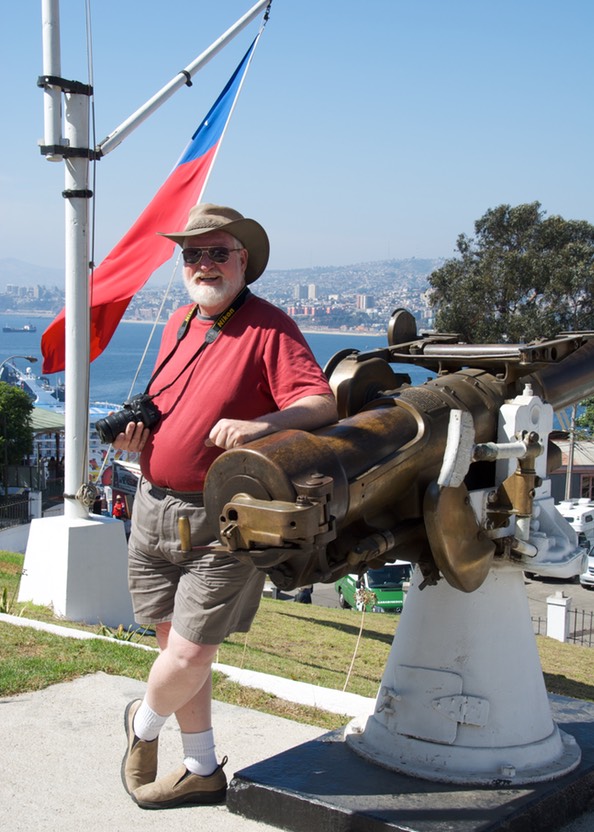
We had strategically placed ourselves along the highway near Santiago, knowing they would come through at some point, and hoping for one last visit. And this is where the German couple found us (“sieze the day,” above). Eventually we got an email from the Aussies, saying they were headed toward Los Andes, a bit to the north and on our route toward the pass and Argentina. We were ready, so off we went, hoping to exchange hugs with them one last time.
Sadly, we never quite caught them. But Los Andes proved to be a charming town, and we were happy to be there. The plaza was delightful, the ice cream also. We were able to change our excess Chilean money into Argentine pesos, and also managed to find propane. Too cool.
Looking for a place to spend our last night in Chile, we were wary of staying in Los Andes because the circus was in town. We wandered further afield, and suddenly saw a sign for a sports complex in a lovely tree-shaded old area on the edge of town. It turns out this was the sports complex for the local university. We got permission to spend the night, and parked next to the track field, which was apparently being prepared for an up-coming meet. The caretaker, Raoul, and his wife, Barbara, were wonderful to us; we were able to take the best showers we’ve had in months, and had a lovely quiet night.
One possible problem would be the military complex next door. We wondered if they would be noisy, and we did get to listen to target practice in the early evening (blanks only, Raoul assured us), but that stopped well before dark. And then, about 6:30 am we were treated to reveille (but soft, in the distance), and later on singing and more target practice. Never a problem, simply charming.
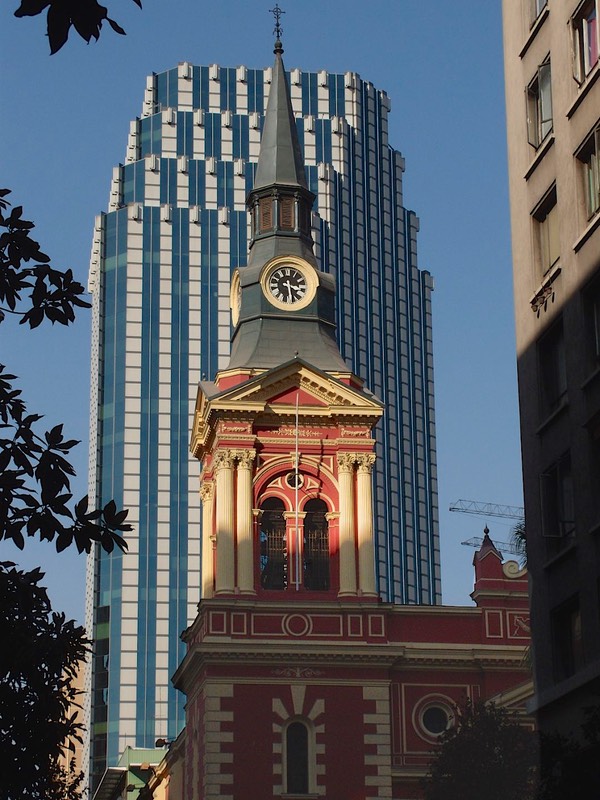
In the morning, after goodbye hugs, we were on our way to Argentina. I was in my usual twitchy state before crossing a border, and this was one where I had had so much trouble with the Border Bastards. But for once the gods smiled on me; we had no produce inspection at all! On we sailed, back into the land of the gaucho. We were jazzed.
So, what of Chile? All told we’ve spent nearly three months in the long, skinny and varied country and have enjoyed it a lot. The variety is amazing, from the Atacama, the driest desert on earth, in the north; to rain forests and glaciers in the south. About 2,600 miles long and seldom more than about 150 miles wide, neither the Andes nor the Pacific are ever very far away. One of the most prosperous countries in South America, the cities and highways seem constantly busy, the vehicles are often new and expensive, and the people frequently well dressed and sophisticated. But an older, more relaxed Chile is also never far away. Off the highway, small farms seem alive and well with their attendant livestock and horse-drawn carts. The southern third of the country is very remote and in many ways untouched by modern life. From the quiet fishing villages of Chiloé, to larger cities like Coyhaique accessible primarily by ferry, to huge ice packs and forested fjords all the way down to incredible Torres del Paine, accessible only via neighboring Argentina; this part of the country increasingly draws tourists to one of the most unspoiled coastal landscapes in the world. We really liked Chile, and in exchanging thoughts with other overland travelers we’ve met, find that they all like it too.
Rick, Kathy, and a rejuvenated La Tortuga.
Click the link to see more photos from Central Chile.